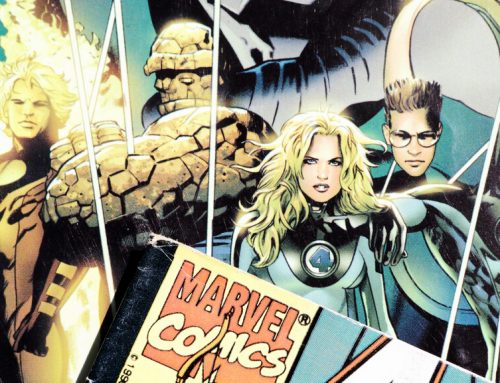When looking at the world today, it seems almost impossible to believe that there was a time when interracial couples were considered risqué.
Was there ever a world that would have looked askance at Kim and Kanye’s union, or questioned whether John Legend and Chrissie Teigan weren’t made for each other?
Of course, we can credit a more open-minded world-wide perspective for the wider acceptance of interracial couples, but we can also credit the silver screen.
Let’s take a moment to look back on some of the most triumphant interracial moments in cinematic history.
West Side Story (1961)
West Side Story is the story of the Puerto Rican Sharks vs. the Caucasian Jets. Tony and Maria are the star-crossed lovers, members of opposite gangs who end up falling in love. As things heat up between Shark Tony (Richard Beymar) and Jet Maria (Natalie Wood), things also heat up between the Sharks and the Jets.
Despite its tragic ending, most of West Side Story is a celebration. As the Sharks and Jets plot against one another, the audience gets a musical drama filled with an amazing score, elaborate costumes, and saucy dialogue. “West Side Story” is triumphant in its portrayal of Puerto Ricans dealing with cultural issues in New York, as well as serving as a classic love story for all generation.
It all culminates in a heartbreaking scene between Tony and Maria in which under the moonlight, the two take their lives. “West Side Story” broke ground by bringing the Shakespearean concept of love between members of two rival groups into an urban setting.
Island in the Sun (1957)
Meet triple threat, David Boyeur (Harry Belafonte). Good looking, powerful and black, he’s bound to stir things up in the primarily white island of Santa Marta, for both the politicians and the ladies. When he meets the upper-class Mavis Johnson (Joan Fontaine) at a party, he does just that.
Although love doesn’t triumph in the movie, “Island in the Sun” the kiss that never happened between Harry Belafonte and Joan Fontaine certainly did. Apparently, the producer of the movie was so nervous about the kiss, that he kept urging the characters to downplay the sexual heat, saying, “We should keep the romance or sex out to the relationship.”
It seems that that’s what played out in the end. While “Island in the Sun” is often referred to as the movie with the first interracial kiss, the kiss didn’t make the cut. Still, it deserves honorable mention.
Guess Who’s Coming to Dinner (1967)
“Guess Who’s Coming to Dinner” added something to interracial cinema that we had never seen before: humor. It showed us that no matter what the color of our skin, we could all agree on laughter.
The movie begins when daughter, Joanna Drayton (Katherine Houghton), announces to her upper-class liberal parents that she’s bringing her new fiancé to dinner. Her parents, Matt and Christina Drayton (Spencer Tracy and Katherine Hepburn) have always instilled the ideals of racial equality in their daughter, so they should have no problem when they find out the fiancé is a black man named John Prentiss (Sidney Poitier). Unfortunately, they do have a problem and it makes them question how liberal they really are.
Matt and Christina become intensely uncomfortable with the idea of their daughter marrying a black man and struggle to come to terms with it. Enter neighbors, priests, and family members and it ends with a dinner to remember and a movie that would make the world look at interracial love in a new way. “Guess Who’s Coming to Dinner” made big strides by uniting us with laughter and helping us move past an outdated concept.
The Landlord (1970)
When young and privileged Elgar Enders, played by Beau Bridges, moved to Brooklyn, he didn’t do it with the intentions of becoming a landlord of a rundown tenement, but then again, things don’t always go according to plan.
Wide-eyed and naïve, Elgar Enders travels to Brooklyn seeking to revamp a tenement building with the hopes of turning it into a luxury home for himself. However, when he gets there and meets the tenants, he is so enamored with their charm, he chooses to turn it into a better home for them.
But that’s not the end of Elgar’s flirtation with the lower class. Elgar proves his authenticity by falling in love with not one but two black women. Although one relationship flickers out, the other heats up and ends in a pregnancy that leaves Elgar with a lot of ‘splaining to do, especially to his conventional parents and his love interest’s not so conventional black radical husband.
“The Landlord is a “power to the people” movie. It’s about street justice and races coming together to fight societal wrongs, and it’s also about love. When Edgar takes responsibility for his mixed raced child, he proves that it takes more than muscle to be a man and more than hatred to define society.
La Bamba (1987)
“La Bamba” is the story of Ritchie Valens nee Valenzuela, the Mexican American kid with the big voice who hit the big time. He broke records on the charts with his Latino edged numbers and in doing so, won the heart of Donna Ludwig. Unfortunately, her father was not so smitten with the idea of Donna taking up with a Mexican American musician.
Despite this, the couple stayed together for two years until the plane crash ended the relationship and also, tragically, Valens’ life.
Richie Valens was the one that made it, the one that got to the top and the who gave the green light to so many following in his footsteps. His legacy is not just an ethic triumph, it is the culmination of the American dream where integration can be just as important as success.
Jungle Fever (1991)
Sometimes, even interracial love can happen for the wrong reason. “Jungle Fever” explores how a sexual fantasy turns into harsh reality for one mixed-race couple.
When Italian American Angie Tucci (Anabella Sciorra) first walks into the office of the happily married successful black architect, Flipper Purify (Wesley Snipes), the story has already been written.
Eventually, what once looked like an office begins to look more like a setting for a rock video. When her white feminine skin meets his male prowess it culminates in sex on the desk. Interraciality never looked so good.
As the film unfolds, however, interraciality begins to not look so good. Her family is enraged, his reacts with shock. Raw emotions are exposed, and underlying problems surface.
“Jungle Fever” is about how the allure of a mixed relationship can blind individuals to the baggage that comes with it. Even though the image of interracial love is glamorous, there are still a lot of issues that need to be dealt with before it will be fully accepted.
Mississippi Masala (1991)
Mississippi is a state in the southern United States, masala is an Indian dish. When the two combine, things can get very spicy indeed.
The film starts in the troubled country of Uganda in 1972. Dictator Idi Armin has just enacted the forceful removal of all Asians in the country. Mina and her brother Jay settle in Mississippi. The political atmosphere has in Uganda left a sour taste in Jay’s mouth. He is unable to accept the American ways of life and is distrustful of black people.
Mina, on the other hand, has no such problems. She’s loving America, and she’s also loving Demetrius, an African American self-employed carpet cleaner. Things don’t sit well with the Indians or the blacks, and Demetrius and Mina must conduct their affair in private.
Mississippi Masala climaxes when the relationship is revealed. What ensues is a lot of hatred, followed by a lot of self- realization. Demetrius and Mina may not have a place in Mississippi or Uganda but they do have a place together, and that’s enough for them to call home.
Joy Luck Club (1993)
Maybe this movie did not have an all-Asian cast, but there’s no doubt “Crazy Rich Asians” would not be as well received were it not for “Joy Luck Club.”
“Joy Luck Club” is for the most part, about Chinese American women and their mothers, but mothers can play a big role in their daughters’ romantic lives, and this film is a testimonial to that.
In “Joy Luck Club” we see two mothers of the same background reacting very differently to their daughters’ romantic choices. When Rose Hsu (Rosalind Chao) begins to date white college student, Andrew Jordan, her mother is enraged. Andrew overhears a conversation between the two and brings things to a head by offering her his hand in marriage.
Conversely, when Waverly Jong brings her romantic interest to dinner, his lack of knowledge about Chinese etiquette embarrass her. The film demonstrates that while mothers and daughters don’t always see eye to eye, they can always come to a common ground.
Café Au Lait (1993)
If you’ve ever watched the daytime reality show “Who’s the Father?” you might have some idea of the plot of “Café Au Lait.”
This French film begins with a mixed-race Martinique woman named Lola (Julie Mauduech) who finds out she is pregnant. The only question is who the father is.
Is it Felix, her white Jewish working-class beau, or her rich, exotic African-Muslim lover, Jamal?
While they wait for the big reveal, the unlikely trio move into an apartment together, neither willing to part with Lola, and neither willing to concede to one another. After much trivial head-butting and racist comments, the baby arrives, and suddenly it seems the friendship that has formed has made the parentage of the baby insignificant.
Fools Rush In (1997)
“Fools Rush In” brings interracial romance to rom-com. Here, the lovely Isabel, played by Selma Hayek, finds that three months after a one nighter with Alex Whitman, played by Matthew Perry, she is pregnant.
The heretofore “sworn bachelor,” decides to make an honest man of himself and with an Elvis impersonator’s blessing, marries Isabel, which doesn’t sit well with either of their families.
From there, the traditional rom-com plot plays out, Isabel runs away and tells Alex she has lost the baby. Alex travels to Mexico to find Isabel. The two declare their never-ending love for one another, and Isabel gives birth on the Hoover Dam.
The Bodyguard (1992)
When Rachel Marron (Whitney Houston) and Frank Farmer (Kevin Costner) first meet its pretty clear they have very little in common.
He’s a professional bodyguard, she’s a professional actress. She’s a diva, he’s overprotective. And oh yeah, did we happen to mention she’s black and he’s white?
When a bomb explodes inside a doll in Rachel’s dressing room, her manager assigns Frank as Rachel’s bodyguard. Although at first, the two are at odds with one another, they end up sleeping together, in a heat of passion Frank would come to regret.
He calls off the romance, but the relationship continues as Rachel’s stalker gets closer. When Frank takes a bullet for her, she sees him as her hero, hence the song.
The film ends with Rachel stopping Frank’s plane for a passionate kiss.
Everything, Everything (2017)
While most of the movies on this list are breaking ground for the attention they focus on interracial love, Everything, Everything is breaking ground for not focusing attention on interracial love.
The young adult love story revolves around the coupling of actors Amandla Stenberg, who is biracial and Nick Robinson, who is white. Onscreen, the plot centers around one of the character’s immune deficiency, refreshingly, race never enters the picture.
This film is revolutionary in the sense that it introduces the concept of “colorblind casting,” a term used to describe movies that feature interracial couples without making it a plot point. Suddenly, the viewer is not looking at a movie about race, he or she is looking at a movie. Hopefully, one day all of life will look like that.






Leave A Comment